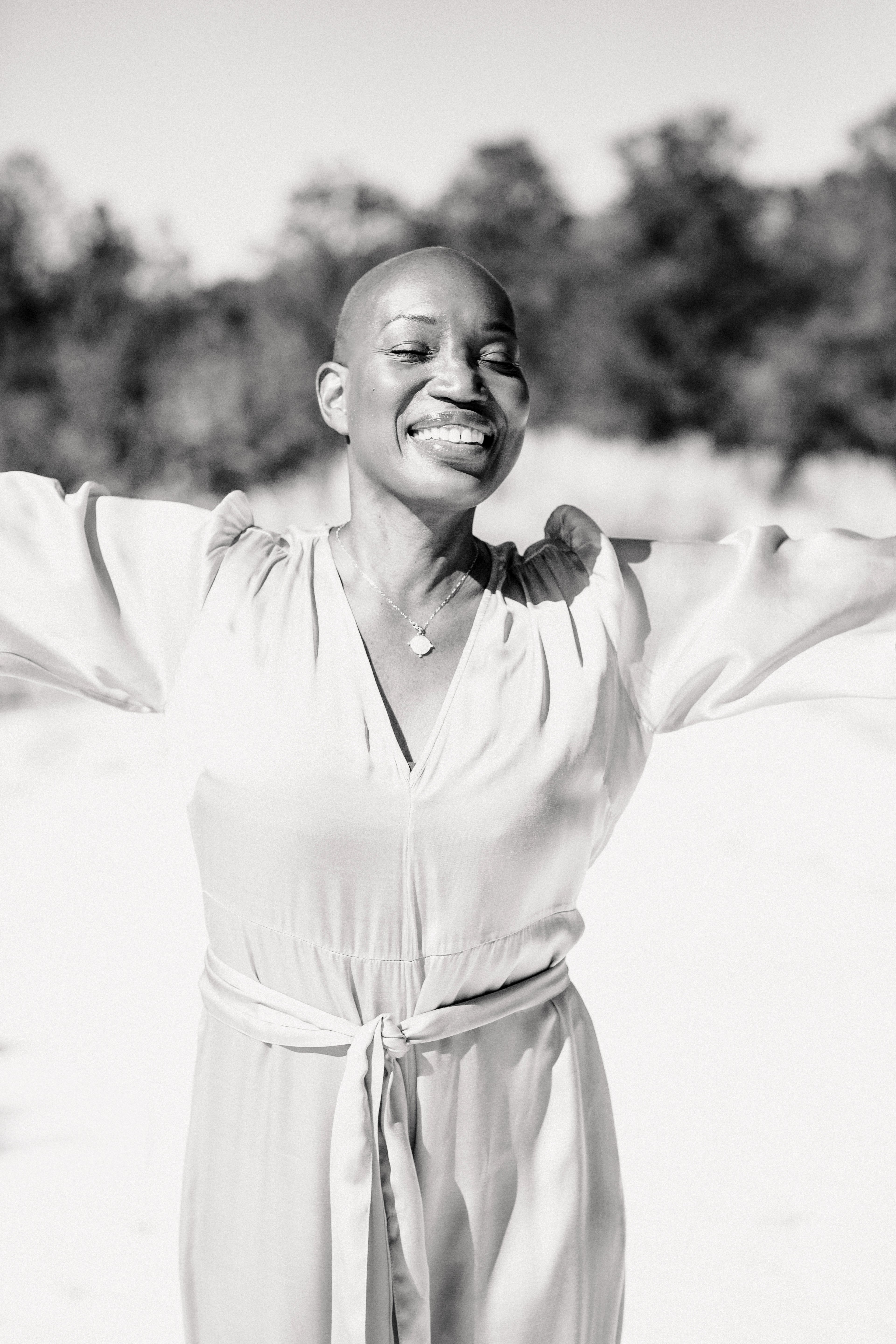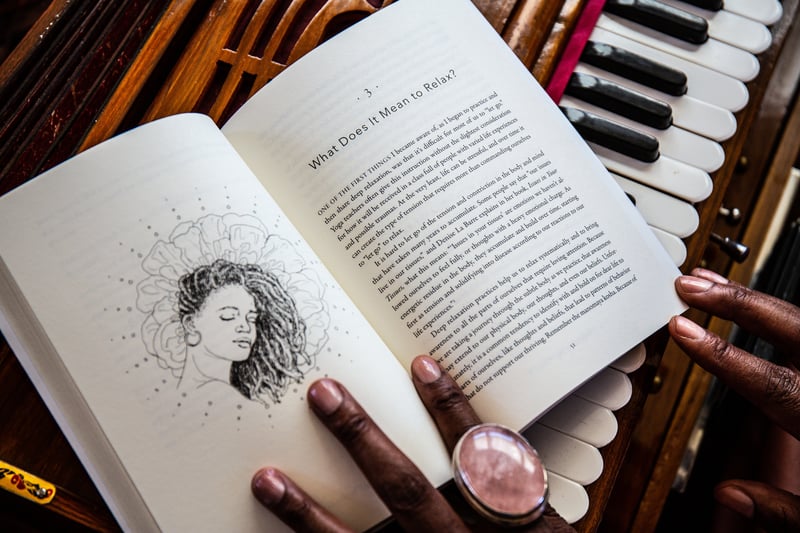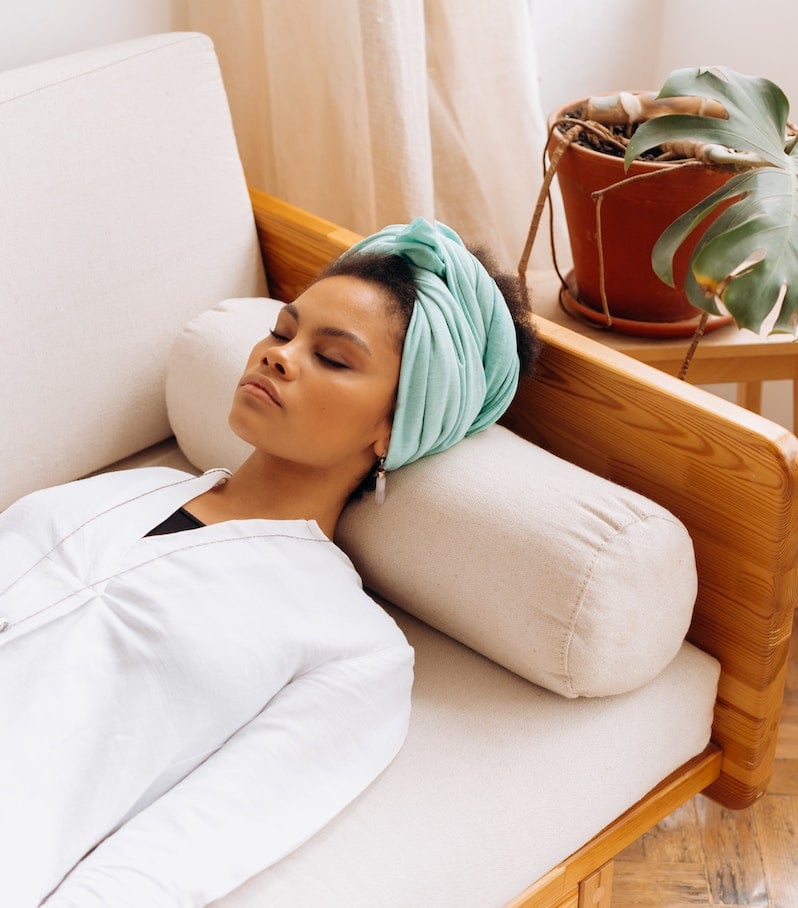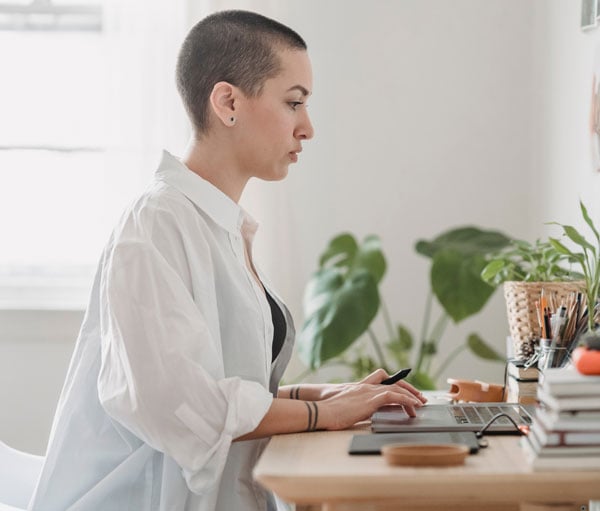A former film executive, yoga nidra teacher and best-selling author Tracee Stanley is now fully devoted to creating containers for self-empowerment, self-inquiry, sankalpa and yoga nidra. Her book Radiant Rest: Yoga Nidra for Deep Relaxation and Awakened Clarity, Radiant Rest podcast, courses and workshops are all geared to her current dharma, namely helping people find calm in the midst of chaos, connect their own powers of transformation, and fully activate their inner radiance.
What personal journey or experience brought you to yoga nidra?
I was introduced to the practice in 2001. I was in a high pressure job producing movies in Hollywood, and it was literally the saving grace for me. I realized right away that through yoga nidra, I could access a place that was deep and still within me within a very short period of time.
In the beginning I looked at it more as almost a life hack. Like, “I can work 16 hours a day and I can do this practice and I can feel as refreshed as if I've slept for eight hours.” And then I started to notice that I was able to be more clear, innovative and creative when I did the practice than when I didn't do the practice. So I started to do it daily, at the same time that I was producing films.
I also had a little donation based yoga studio in West Hollywood, because yoga had transformed my life so much and I wanted to have a place where people could practice where money was not going to be an object for people to be able to access the teachings.
And before I knew it, I started teaching yoga classes. I was teaching dynamic physical yoga classes, but I would always add in some of the deep relaxation techniques that I was doing. People would always ask at the beginning of classes if we were going to the “that sleep thing” again. So I started to realize that this was the medicine that people really needed. This was before we had all the social media and everything else that we have now, which has just increased the need for it. And then when we all got locked down, people were able to dig into it and stick with it a bit more.
In the beginning I looked at it as almost a life hack. Like, I can work 16 hours a day and I can do this practice and I can feel as refreshed as if I've slept for eight hours.
So tell us, what exactly is yoga nidra? What does it mean and what’s the practice like?
Yoga nidra is defined as “the yoga of sleep.” It’s a systematic technique that allows you to intentionally and consciously enter the state of deep sleep. And more than just the technique, it's actually a state of consciousness said to be similar to a place that is peace beyond words. Yoga nidra is also a goddess who is talked about in the Devi Mahatmya. In this way, we can imagine being presided over by a feminine force of nurturing and repose, of being held and having unconditional support.
On an entry level, this is a systematic, deep relaxation practice. You lie in shavasana, or corpse pose, observe the body breathing, bringing awareness to diaphragmatic breath. This allows you to activate the parasympathetic nervous system, which is that nervous system of rest and digest mode. And at the same time, you may be asked to visualize certain things, which brings your mind into a one-pointed focus and then allows you to drop deeper into the experience.
So yoga nidra is actually this practice of dissolution, and the dissolution is that normally we're only aware that we are a physical body with this certain identity or personality. With yoga nidra, you can start to become aware that you are also energy and energy is expansive. And from there you become aware of thought constructs and beliefs, and even the origins of certain beliefs that you might be holding. It creates this kind of expansion and spaciousness that allows wisdom to drop down. There's a place within us that is always wise and always at rest. Essentially what we're doing in yoga nidra is dissolving our awareness and our attachment to name and form so that we can return back to that place within us, a place that is always at rest.

If someone is reading this interview and thinking: I want that. How difficult is it to learn and what does it take to get to “that place”?
A lot of the forms of yoga have these levels where you have to have done a certain practice before you get to the next level. And yoga nidra is really the beginner's friend, because you can have, as I did in 2001, a very deep experience the first time you do the practice. So there isn't anything that is needed other than you listening to the instructions and following them.
For beginners, I recommend listening to an audio recording. And as you listen to the audio recording, you are going to be asked to lay down in a position where the body is completely supported and can be at ease. That allows you to surrender. You are then guided into observing the breath, perhaps just watching the naval rise and fall. You may be guided to systematically begin to relax certain parts of your body. When we do that, especially for the first few times, we start to realize that we have a lot of resistance and a lot of holding that we're not even aware of. So that is the first kind of step: to touch into where I am feeling resistance and see if I can release the resistance with breath? In other words, can I trust the earth to hold my body?
From there, you might be asked to visualize something. There are different elements in the practice but what it comes down to in nidra is that we don’t need to put our foot behind our head to get to a spacious awareness. We just need to lie down, be aware of our breath and restfully connect with our heart center, as that is often believed to be the portal to this peace beyond words.
A lot of people say that three hours of sleep is equal to doing yoga nidra for 30 minutes. I’m waiting to see the scientific research on that, but it wouldn’t surprise me at all if that were true.
What if you fall asleep?
It’s so interesting! A lot of people will say that they fall asleep, but yet they wake up at the end when the teacher is saying it's time to come back. That shows that there is a part of us that is awake and aware, right? And when we start to practice yoga nidra, what we're really doing is touching into that place that is awake and aware, and we're threading it through all of the states of consciousness. So yoga nidra is more than the yoga of sleep. It is the yoga of awakening in that it’s taking conscious awareness and allowing part of us to stay awake and aware as we move through all of those transitional states. It's a really beautiful journey.
And also, if you fall asleep, then you probably need to rest. Which is why I think the practice is so practical for so many people, because it can be used as a sleep aid. It can be used as a spiritual practice. It is a spiritual practice. It can be a portal into cultivating a deeper relationship with yoga as a state of consciousness. It’s applicable for anybody. I think the only thing that sometimes stops people from practicing is that the word “yoga” is in the title.
What are the most surprising benefits of this modality? How have you seen it help or heal people?
How immediately you begin to feel rested. You’re accessing states of deep rest that are related to Theta and Delta brainwave states, accessing NREM sleep in a shorter period of time. A lot of people say that three hours of sleep is equal to doing yoga nidra for 30 minutes. I’m waiting to see the scientific research on that, but it wouldn’t surprise me at all if that were true.
Other benefits include enhanced intuition, enhanced memory, the ability of self-healing to be activated. And on a more mystical level, it’s not unusual for people to report becoming in touch with ancestors and spirit guides.
How long does it take for people to feel the effects?
It can be immediate.
How often should you practice?
It depends. If your reason for practicing is that you have insomnia or you’re feeling exhausted, you want to practice 2-3 times a week. If you just want to feel more rested, try 15 minutes a couple of times a week. If you are interested in deepening your spiritual life, then I recommend doing a 40 day practice. Practicing every day consecutively for 40 days with a journaling practice, that is a game changer.
And what about what you refer to in your book as “The Householder’s Flow”?
The Householder's Flow is this idea that I think most of us should adopt, because I don’t really know anyone who has three hours a day to meditate. So it’s this idea of making your life a practice and being able to find the transitions in the day, whether those transitions be 2 minutes or 15 minutes, and being able to drop into practice for that short period of time, throughout the day, each day, so that you are creating a thread. We're threading the awareness that every moment in every transition during the day gives us an opportunity to practice. So that might look like two minutes of alternate nostril breathing in the morning while you watch the sunrise, or even just like looking into the sky to see the light, as well as five minutes of just lying down and allowing the body to rest and doing a body scan. We want to prepare our bodies to be receptive to relaxation. So the more you do these techniques combined with yoga nidra, the less time you need to prepare to receive a state of deep relaxation.

Any other non-negotiable wellness rituals in your day or life?
First of all, just hovering in that liminal space as I come out of sleep. Meditation. Mind-mapping and journaling. Observing the sun rising. Breathwork/Pranayama including alternate nostril breathing. So hum meditation in the spine. Yoga nidra, obviously, during the day. And then I have a sleep practice that I discuss in the book which is sometimes a lucid dreaming practice, and most of the time a practice of observing the body as it moves deeper and deeper towards sleep. Observing the exact opposite of that liminal sleeping to waking; in this case it becomes from waking to sleeping. And placing a mantra or a prayer at the heart and letting that kind of weave through my sleep time. So that when I wake up, I remember that prayer or that blessing in the liminal. It becomes a 24-hour cycle of practice. There's actually very little effort that has to happen with that. When it becomes part of just the fabric of everything, it's just kind of what I do.
What do you hope to see more of or change in the "wellness" industry?
I'm not a fan of this idea of the wellness industry to begin with. It's like, what does that mean? However, that said, what I would like to see is acknowledgement of where these practices and wisdom that are being shared come from. I do see a lot of, um, wisdom being shared that I know comes from Ayurveda or that I know comes from yoga philosophy or that I know comes from other indigenous cultures. And that is not being acknowledged. I believe that as practitioners we have to do our research, because when we water something down, because we want to claim it as our own, it really does a disservice to the original vibration and frequency of the healing potential. Because clearly they work, right? Which is why people are sharing them and we're sharing them. But I think the more we can get closer to the origin of it, the more that we then have access to what in yoga is called “transmission,” the ability to actually transmit a teaching that ripples throughout your whole life.
What question you wish people would ask you in an interview?
There is a question that I love to ask people. And so I guess I would like to have it turned on to me? It’s: What lesson are you tired of learning?
What lesson are you tired of learning?
The lesson that I'm tired of learning is that my worth is somewhere out there.
What healing do you still have to do? And how do/will you approach that?
I think the healing I have to do still revolves around forgiveness. I've done a lot of work on this, but there's a member of my extended family who, when my father was dying, forged documents and stole money. That's one thing. But it’s not about the money. It's really about the level of betrayal and deception. I've worked layers and layers to move into forgiveness and I've forgiven a lot, but I also know that there's still a piece in there that isn't fully forgiven. So I’ll keep working on love, forgiving, kindness, compassion - all that. I don't believe that you actually have to have the person present in order to move through the forgiveness, but I do want every minuscule vibration out of my being that isn't in forgiveness.
What's one thing anyone can do today if they are struggling with sleep or want more rest in their life?
Download this yoga nidra offering or try my course for free for 14 days on Commune.
Personal wellness mantra or philosophy?
REST is my birthright.
Where do you turn for wisdom?
Places: My secret spots in nature—anywhere the water flows in northern New Mexico or where I can watch the sun and moon rise in silence.
Teachers: My mother, mother nature. My practice is a teacher.
Books: Anything by Dr. David Frawley, Yoga by Indu Arora, Ancestral Wisdom by Daniel Foor, Prayers of Honoring by Pixie Lighthorse, Dream Yoga by Andrew Holecheck, my own journals
Podcasts: Huberman lab, Living Myth with Micheal Meade, Hey, Girl with Alex Elle, Finding Refuge with Michelle Cassandra Johnson

Meet the first digital holistic health studio
Access thousands of live and on-demand classes for mind, body, and emotional wellbeing with a WellSet membership.

Support your team’s wellbeing with WellSet
Bring WellSet to your workplace and decrease employee burnout with the first digital holistic solution backed by insurers.
This article mentions: Mindfulness, Sleep, Yoga Nidra
